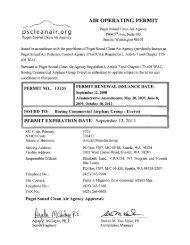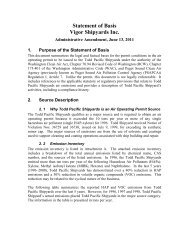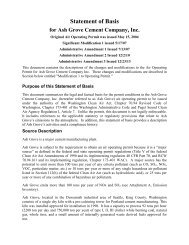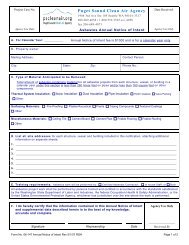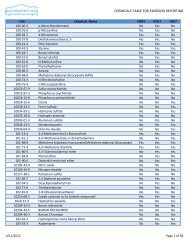Additional Comments Summary Response to Additional Comments
Additional Comments Summary Response to Additional Comments
Additional Comments Summary Response to Additional Comments
You also want an ePaper? Increase the reach of your titles
YUMPU automatically turns print PDFs into web optimized ePapers that Google loves.
RESPONSE SUMMARY<br />
REVISED DRAFT ORDER OF APPROVAL NO. 10052<br />
Comment Period – September 13 – Oc<strong>to</strong>ber 28, 2010<br />
Commenter<br />
Comment Synopsis<br />
department's concern about the potential for vec<strong>to</strong>r access <strong>to</strong> the food waste<br />
component of the residential collections. Cedar Grove also believed that<br />
use of the tarps would incidentally reduce the potential for odors<br />
from the piles. Cedar Grove did not believe these zones <strong>to</strong> be significant<br />
odor sources. However, Cedar Grove learned that at least one PSCAA<br />
inspec<strong>to</strong>r was telling residents that "garbage" odors they were experiencing<br />
were attributable <strong>to</strong> Cedar Grove accepting food waste for composting. In<br />
fact, that inspec<strong>to</strong>r acknowledged earlier this week that he had never<br />
smelled a "garbage" odor offsite from Cedar Grove that he attributed <strong>to</strong> the<br />
compo sting facility. Nevertheless, there has continued <strong>to</strong> be public<br />
speculation that acceptance of food waste had increased odors from the<br />
Maple Valley facility. Cedar Grove <strong>to</strong>ld PSCAA management about the<br />
idea of using the tarps on Zones 1-6 earlier this year, and launched a pilot<br />
in June <strong>to</strong> see if the tarps would alter the composting process. The pilot<br />
showed that the covered piles remained aerobic and composted normally.<br />
Unfortunately, PSCAA's inspec<strong>to</strong>r <strong>to</strong>ok the position that this pilot violated<br />
Cedar Grove's permits for zones 1-6. Accordingly, Cedar Grove suspended<br />
the experiment in early July. In considering ways <strong>to</strong> respond <strong>to</strong> odor<br />
complaints during July and August of this year, Cedar Grove suggested<br />
that approval for use of the tarps on Zones 1-6 be included in this revised<br />
Draft Order. PSCAA informed Cedar Grove that this request had been<br />
made <strong>to</strong>o late in the process, and would have <strong>to</strong> be addressed in a separate<br />
NOC. PSCAA's air engineer also requested more information about the<br />
effect of the tarps on performance of the existing negative aeration system<br />
serving Zones 1-6, and on the compo sting process. In order <strong>to</strong> demonstrate<br />
that the tarps would not adversely affect either the composting process or<br />
the negative aeration system, Cedar Grove initiated another pilot with use<br />
of the tarps in Zones 1-6. As part of the pilot, Cedar Grove had a third<br />
party contrac<strong>to</strong>r take air samples on <strong>to</strong>p of piles that were covered and<br />
uncovered and ship those sampled <strong>to</strong> a lab for odor analysis. Also,<br />
responding <strong>to</strong> the concern about the impact of residential food waste on<br />
odors, Cedar Grove prepared a pile consisting only of yard waste and<br />
collected an air sample above that pile as well. This sampling showed that<br />
the pile containing a mix of yard and food waste actually produced<br />
about half as much odor as the yard waste pile. Part of the explanation<br />
appears <strong>to</strong> be a higher carbon content in the mixed waste pile, due for<br />
example <strong>to</strong> the paper based feeds<strong>to</strong>cks (pizza boxes, etc.) that routinely<br />
accompany residential food waste. Incidentally, this sampling disproves<br />
the concern that the addition of a small food waste component in Zones 1-6<br />
has increased odors from the site. The sampling also showed, not<br />
surprisingly, that odors above the tarped pile were much lower; about half<br />
of the result above the mixed waste pile, and about a quarter of that of the<br />
yard waste pile. Pile temperatures and oxygen levels demonstrated that the<br />
covered pile remained aerobic and composted properly. Cedar Grove's<br />
contrac<strong>to</strong>r also compared static pressure and fan operations between a



